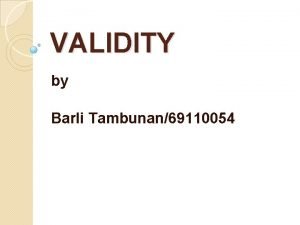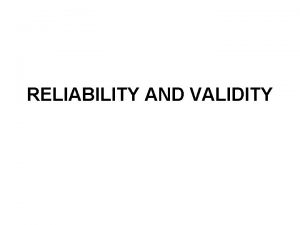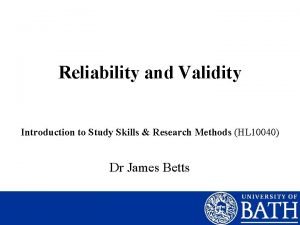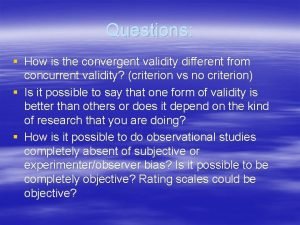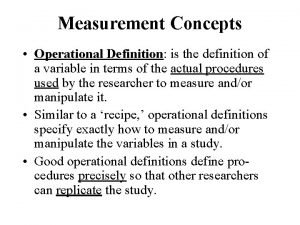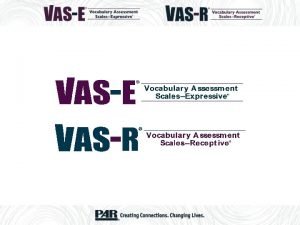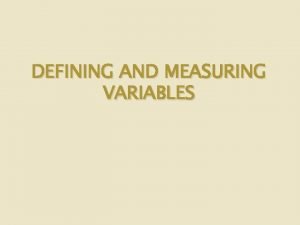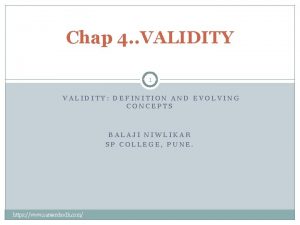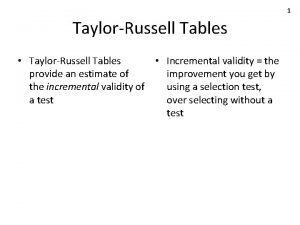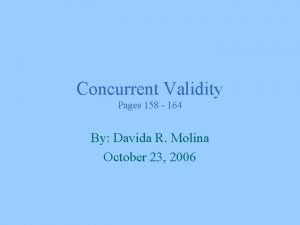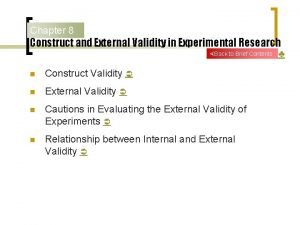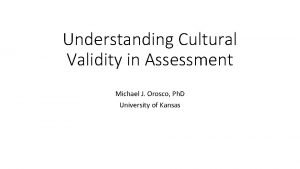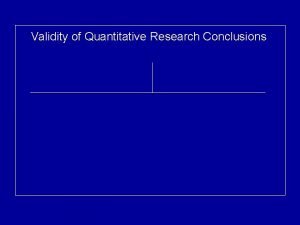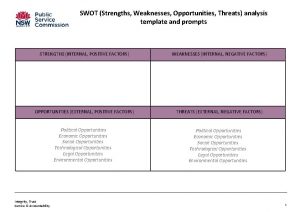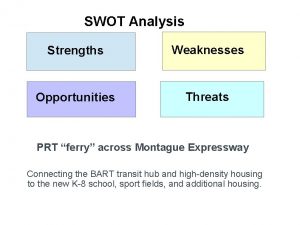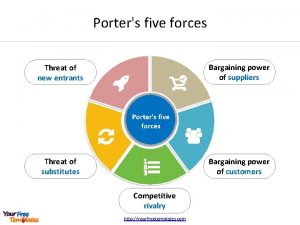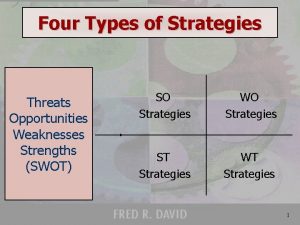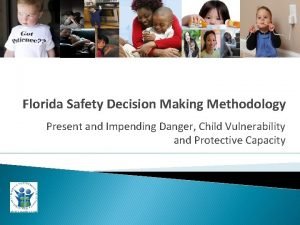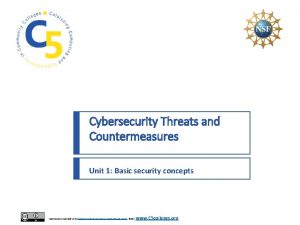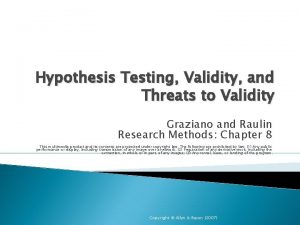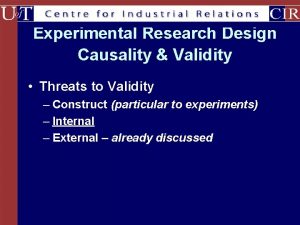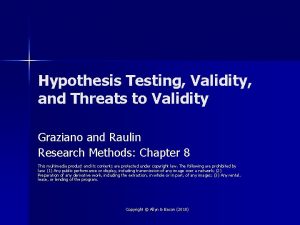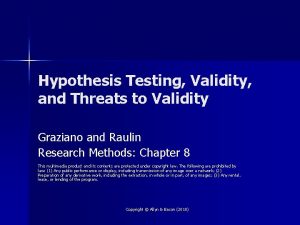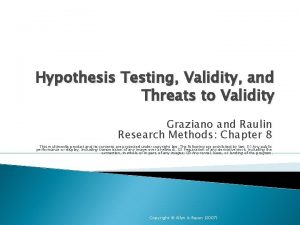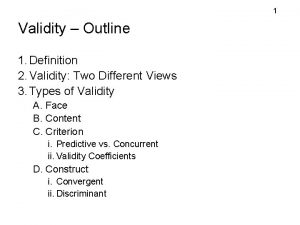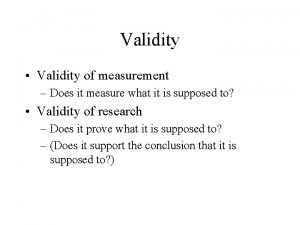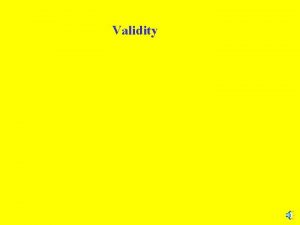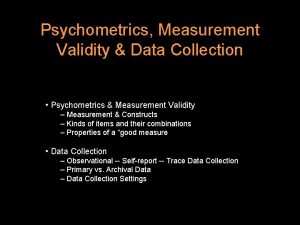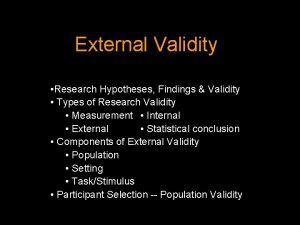Threats to Validity Threats to validity definition Theory
































- Slides: 32

Threats to Validity • Threats to validity – definition • Theory vs. measurement • Types of validity – – Conclusion validity Internal validity Construct validity External validity • Particular threats to validity Validity

Threats to validity - definition • Researchers do not simply • The description is not like report facts. a photograph – it is not “veridical. ” It can be wrong in a variety of ways. • The researcher’s task is • Problems that cause our like describing an object descriptions to be wrong covered by a thick blanket. are problems of validity. Validity

Theory vs. measurement • Our interest is always in the validity of a conclusion or inference Theory • That validity can be threatened either by poor measurement or by poor theory Validity Measurement

Theory vs. measurement • Our theory predicts that we will observe a relationship between measurable variables (that is, variables we have operationalized). • We won’t see the expected relationship if Validity – theory is incorrect, or – the operationalizations are flawed.

Cause Effect Independent Variable Validity Dependent Variable

Theory vs. measurement • Suppose you believe that absence makes the heart grow fonder. • Your theory has two constructs: – Absence – Fondness. • Both must be ‘operationalized. ’ Validity

Absence Fondness # days apart # phone calls We might not see the expected relationship because our theory is wrong operationalizations are poor. Validity

Types of Validity • Does our study have: – Is the relationship between variables seen in the data the one that our theory claims should be there? – conclusion validity? Validity

Types of Validity • Does our study have: – Is the relationship between variables causal? (A B) – conclusion validity? – internal validity? Validity

Types of Validity • Does our study have: • – conclusion validity? – internal validity? – construct validity? Does the I. V. capture our theoretical cause? • Does the D. V. capture our theoretical effect? Validity

Types of Validity • Does our study have: – Will the findings in our study be replicated in other settings? – conclusion validity? – internal validity? – construct validity? – internal validity? Validity

Conclusion Validity I. V. D. V. Validity

Internal Validity • If there is some confounding variable – one that varies # days apart with our I. V. – then our study lacks internal validity # phone calls money left Validity

Construct Validity Cause Effect I. V. D. V. Validity

Absence Fondness Distance A different operationalization might produce different conclusions – e. g, if distance varies with the purpose of the trip, which in turn determines how busy the traveler is through the day. Validity # thoughts about loved one

External Validity Cause Effect Validity

Particular threats to validity • On previous slides, we’ve discussed several types of validity. • The next slides list some threats to each type. • You should be able to discuss and give examples of each of these threats. Validity

Threats to Internal Validity • History • changes happening to only one of two or more groups that are compared Validity

Threats to Internal Validity • • History Maturation • changes in performance associated with development Validity

Threats to Internal Validity • • • History Maturation Test practice • changes in performance due to experience with the test format Validity

Threats to Internal Validity • • History Maturation Test practice Regression to the mean • extreme values of measurements are unlikely to be repeated Validity

Threats to Internal Validity • • • History Maturation Test practice Regression to the mean Selection • between-group differences that are present at the start Validity

Threats to Internal Validity • • • History Maturation Test practice Regression to the mean Selection Mortality • differences produced by different rates of dropout between groups Validity

Threats to Conclusion validity • Conclusion validity may be low because of: – poor reliability • increase number of items used in the task • or use more precise measuring instruments Validity

Threats to Conclusion validity • Conclusion validity may be low because of: – poor reliability – weak relationship • increase strength by increasing “dose” • decrease “noise” by increasing reliability or decreasing distractions in the environment Validity

Threats to Conclusion validity • Conclusion validity may be low because of: • Increase number of observations, by – increasing number of subjects – increasing number of trials per subject – poor reliability – weak relationship – lack of statistical power Validity

Threats to Construct Validity • Loose connection between theory and method • Ambiguous effect of independent variables – Hawthorne effect – Good subject tendency – Evaluation apprehension (social desirability, white coat syndrome) Validity

Threats to Construct Validity • Interaction of different treatments • Interaction of testing and treatment. Validity

Threats to External Validity • Any dimension on which studies can differ might produce a failure to replicate. • Our subjects might be special in some way – Other people Validity

Threats to External Validity • Any dimension on which people can differ might produce a failure to replicate. – Other people – Other places • our environment might be special in some way • especially if we work in a lab. Validity

Threats to External Validity • Any dimension on which people can differ might produce a failure to replicate. – Other people – Other places – Other times • our time might be special in some way • e. g. , right after a government report on smoking is released, you survey smokers Validity

Challenge • For each of the following maxims, suggest some operationalization of the relevant constructs: • Too many cooks spoil the broth • Many hands make light work • You snooze, you lose • A rolling stone gathers no moss Validity
 Internally valid definition
Internally valid definition Criterion related validity definition
Criterion related validity definition Construct validity
Construct validity Convergent validity definition
Convergent validity definition Face validity definition
Face validity definition Concurrent criterion validity
Concurrent criterion validity Face validity definition
Face validity definition Reliability and validity definition
Reliability and validity definition Face validity definition
Face validity definition Convergent validity definition
Convergent validity definition Technical and operational definitions of words examples
Technical and operational definitions of words examples Ecological validity definition
Ecological validity definition Face validity
Face validity Internal validity definition
Internal validity definition Validity definition
Validity definition Taylor russell table
Taylor russell table Concurrent validity nedir
Concurrent validity nedir Mono method bias
Mono method bias Cultural validity definition
Cultural validity definition External validity definition
External validity definition Major threats to biodiversity
Major threats to biodiversity Tufted saxifrage adaptations
Tufted saxifrage adaptations Threats to biodiversity a case study of hawaiian birds
Threats to biodiversity a case study of hawaiian birds Strength weakness opportunity threat template
Strength weakness opportunity threat template Strengths opportunities threats weaknesses
Strengths opportunities threats weaknesses Threats of new entrants
Threats of new entrants Owasp automated threat handbook
Owasp automated threat handbook Face goffman
Face goffman Wireless security threats and vulnerabilities
Wireless security threats and vulnerabilities Types of opportunities
Types of opportunities Threats to folk culture
Threats to folk culture Impending danger examples
Impending danger examples Cyber security threats and countermeasures
Cyber security threats and countermeasures




